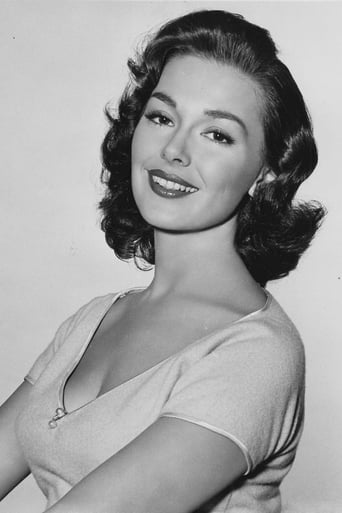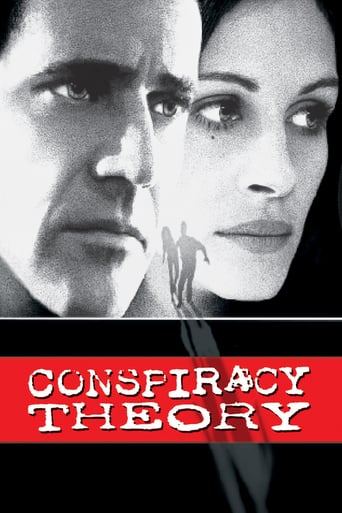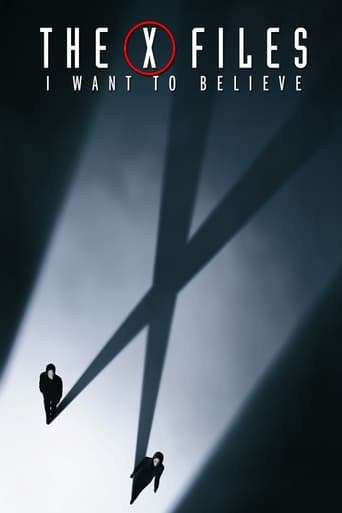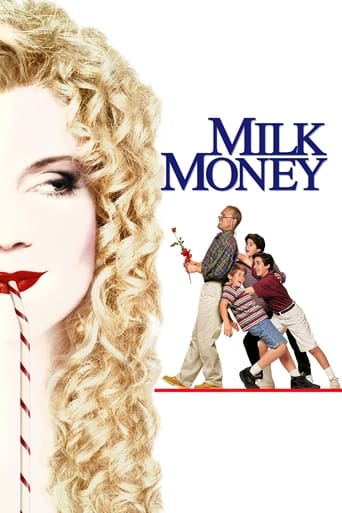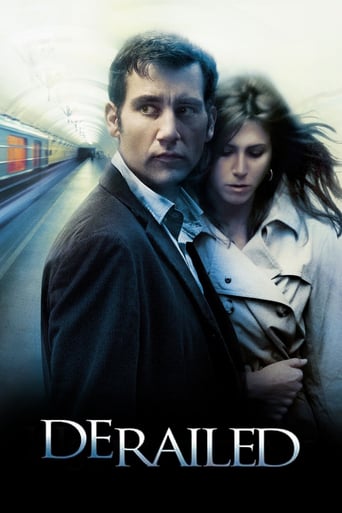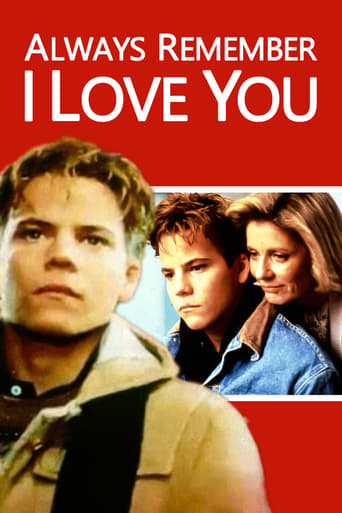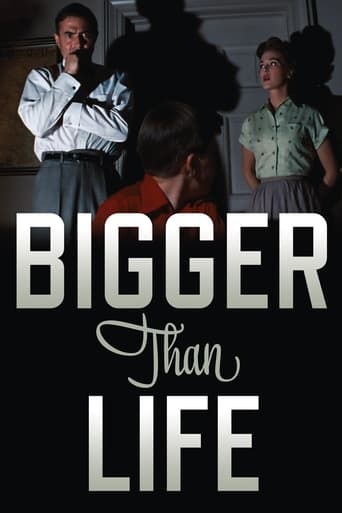
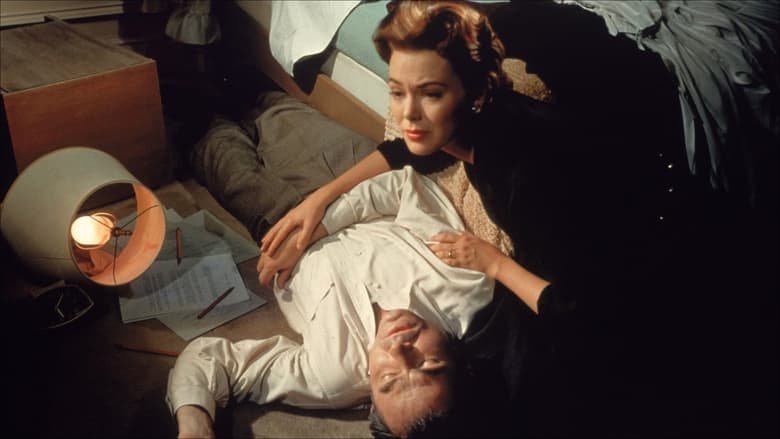
Bigger Than Life (1956)
A friendly, successful suburban teacher and father grows dangerously addicted to cortisone, resulting in his transformation into a household despot.
Watch Trailer
Cast


Similar titles
Reviews
Perfect cast and a good story
best movie i've ever seen.
The film makes a home in your brain and the only cure is to see it again.
Great story, amazing characters, superb action, enthralling cinematography. Yes, this is something I am glad I spent money on.
SYNOPSIS: Based on an actual case history, this movie "dramatically portrays the evils of an indiscriminate use of drugs" such as cortisone and similar steroids like prednisone. NOTES: Mason's first film as a producer and Fox's 59th CinemaScope feature.COMMENT: All the controversy surrounding this film when it was first released has now been forgotten. Although there are still people in the community who would undoubtedly benefit by its message, the film must ultimately stand or fall by the power of its own dramatic story, the credibility of its characterizations, the realism of its acting, and the vigor of its direction. On all these counts, it fails dismally. The story is not forceful. It is dull, long and over-drawn. The characters come over as humdrum, uninteresting, pasteboard figures. They seem not bigger than life, but smaller. Much smaller. The acting, especially by the principals, is often unconvincing. And as for the direction, plodding and uninspired seem too mild to describe the lifeless, static, pedestrian and completely lacking in visual appeal picturization here presented by Nicholas Ray. To quote Rupert Butler: "Some of the CinemaScope set-ups are noticeably awkward and primitive. The use of the wider screen and color seem unnecessary."
This is another of those Lost and Forgotten Films from the 1950's. One that was Criticized, Ignored, Dismissed, and Shelved. Better Forgotten because it just didn't fit. It didn't fit the Archetype Nuclear Family, the Safe Suburbs, the Reliability and Security of the Authority Figure (Father/Teacher), the Church, and Last but not Least, Doctors and Miracle Drugs. This was just Anarchy, Subversive, and probably planted here as some sort of Communist Plot to Undermine the Burgeoning Middle Class. Of course it wasn't but was meant to be. A Scathing Story of the Failures and Flaws of all of those things We hold Dear that were about to show the Cracks in the Mirror of Self Righteousness.The Film is Fascinating when thought of in its Time-Place. It didn't hold much back and Proudly, and without Embarrassment, dared to Poke at the Conventions of the Day. It is Easy to Replace just about anything for the Culprit Cortisone (its abuse causes our Protagonist to Implode), it could be anything, but if Director Nick Ray in Hindsight could do it again, the Poison Pill would have gone Unnamed.This is one of those Antithesis Movies that are a Treat to Rediscover and Look at with Jaded Modern Eyes. What is on View here is a Psychotic Break from the Fragile Safety Net of Cultural Conventions and a Searing Look-See in on the Underneath of the Human Condition. Superbly Shot in a Contrasting Wide Screen Claustrophobic Setting, with some Great Acting and a Director who was most Comfortable causing Chaos among the Comfortable.
From director Nicholas Ray (In a Lonely Place, Rebel Without a Cause), it was later that I heard this film was a melodrama, and it featured in the book 1001 Movies You Must See Before You Die, so I had to see it. Basically Ed Avery (A Star Is Born's James Mason, also producing) is the schoolteacher and family man who is suddenly struck by a series of increasing pains and blackouts, and in hospital it is confirmed that he has a inflammation of the arteries, called polyarteritis nodosa. He is at first told he may have only months to live, which upsets him, his wife Lou (Barbara Rush) and their son Richie (Christopher Olsen), but then they decide to try and experimental hormone drug, cortisone, to see if it will relieve and eventually eliminate the pain, and it seems to work. The doctors tell Ed he will have to take the cortisone tablets indefinitely if he wants prevent the pain and illness returning, and at home he makes a remarkable recovery, returning to his regular routine and home life. However signs start to show that this "miracle cure" has affects on Ed's personality and behaviour, as he starts to misuse and overtake them, causing nightmarish reactions. The drugs are causing him to have constant mood swings, irrational temper, and ultimately hideous and psychotic abuse with violence towards Lou and Richie, threatening their safety. Lou tries ways to get him to take less, or completely rid of the cortisone from her husband, including trying to get his friend, school caretaker Wally Gibbs (Walter Matthau) to help, but this only angers Ed much more. The drugs are eventually taken away from him and he restrained and put into hospital so that the drug affects can lessen and he can get back to his old self, and thankfully in the end he recovers, with no memory of his actions, and the doctors insist he will take much smaller doses in future, but Ed, Lou and Richie hug in relief. Also starring Robert F. Simon as Dr. Norton, Roland Winters as Dr. Ruric, Rachel Stephens as Nurse and Rusty Lane as Bob LaPorte. Mason gives a truly powerful performance as the at first mild-mannered and kind man who completely flips to become a scary, bully like, psychotic, megalomaniac monster towards his family, and Rush is perfect capturing the innocent fear and terror towards him, the bright colour scheme definitely works to create the striking scenes and feeling of unease, it is a must see psychological drama. Very good!
Nicholas Ray directs "Bigger Than Life". The plot? Ed Avery (James Mason), suffering from a fatal inflammation of the arteries, is prescribed an experimental drug. He becomes addicted to this drug, which leads to severe side effects, chief among which is the development of certain tyrannical tendencies.Based on a New Yorker article by Berton Roueche, "Bigger Than Life" initially appears to be one of those condescending "social problem" films about the dangers of drug abuse and addiction (see Otto Preminger's "The Man With The Golden Arm", released the previous year). But it eventually becomes clear that Ray is wholly uninterested in pharmaceuticals. Instead, Ed Avery becomes an existential figure typical of Ray's cinema. He's a man who has turned his back on Post War America, deemed the American Dream precarious and wholly rotten, is ashamed that he must work two jobs to keep his family afloat, barely communicates with his wife and child, finds suburbia to be both dull and devoid of any meaningful substance, deems the post war economic boom to be nothing but vacuous consumerism, and feebly keeps travel posters of exotic locales in his home as a means of extricating himself from a stifling, claustrophobic and wholly toxic situation. "We've become dull," he tells his wife, "I've become dull."Ed's arterial inflammation is therefore not only a literal illness, but a manifestation of what Sartre called "existential nausea", a symptom of both acute consciousness and a toxic environment. In a similar regard, the "miracle drug" which Ed is prescribed becomes a stand-in for any addiction used to dull the senses and escape pain. Recall Ray's "In A Lonely Place" and "On Dangerous Ground", where men face similar anxieties and disappear into either booze or their careers.Ed's breakdown is far more complex than previous Ray "heroes", however. Crushed by the weight of his own impotency/castration, his perceived insignificance, Ed rebels against his failed Oedipal role. He not only begins to resent his wife and son, whom he blames for restricting his freedom and achievements, but becomes a kind of super-ego agent, wholly vengeful, sadistic and punishing. Frighteningly, Ed then inflates further from a symbol of raging patriarchal authority to a fascist figure, denouncing every institutions he comes into contact with (the school, the family, the church, and the general economic hierarchy of postwar America). Only he knows what's best for everyone.It is only when Ed's son points out Ed's failings that Ed's self importance begins to diminish. Forced to cast aside his grandiose plans, Ed ceases exalting himself, and instead starts transposing his desires onto his son, whom he begins grooming and prepping for greatness. But this too fails, resulting in Ed's desire to kill himself and purge the world of his "inferior" wife and child.Before attempting to kill his family, Ed quotes a passage from the Bible in which Abraham offers his son Isaac as a sacrifice to God. The implication, of course, is that Ed, like Abraham, is putting himself above ethics, sacrificing himself and his family for some higher authority. What's interested is that, in the Bible, God intervenes and saves Isaac once Abraham has demonstrated his devotion. The opposite is the case in "Bigger Than Life". "God was wrong!" Avery screams, before attempting murder. Who then is Ed's sacrifice for? Ed's unusual in that he denounces all symbolic authority, all social structures, and even himself as a substitute Ordering Force; suicidally, he wants to be free of all association.Aesthetically, the film mixes domestic horror, melodrama and German Expressionism. Ray's use of macabre shadows and darkness recall the horrors of Fritz Lang, whilst various medical treatments act as a precursor to "The Exorcist", with their eerie red lights and grotesque looking X ray machines. Remove the macro-cosmic, historical themes of Stanley Kubrick's "The Shining" and you likewise have Ray's "Bigger Than Life", both films about school teachers who slowly lose their minds and abuse their families, both exposing what Walter Metz calls the "inherent inadequacies of the patriarchal family structure", both charting the uncanny, where the familiar domestic problems of the "heim" conceal the "unheim", the darker desires of familial annihilation and horrific behaviour.The film makes use of simple, but effective, symbolism. A stairway, the bridge between private and public, becomes the point of violent conflict (as it was in Ray's "Rebel Without a Cause"), and two everyday objects are used repeatedly throughout the film to create different effects. Think the glass of milk Ed drinks during his bridge game, which echoes the glass of barium drunk during an X-ray exam and then becomes the contentious pitcher of milk of the final dinner scene. A simple football is used for similar effect, initially used as a proud mantelpiece, then a source of shame, then an instrument of torture and finally a peace offering. Today, films like "American Beauty", "Blue Velvet", "Little Children", "The Ice Storm", "Revolutionary Road" etc etc are praised for "exposing the horror beneath suburban life". Such films were routinely made in the 1940s and 50s (think "Man in the Gray Flannel Suit", "Trouble in Tahiti", "Shadow of a Doubt", or another James Mason vehicle, "Lolita"), most of which say more than their modern counterparts.Upon release, "Bigger Than Life" wasn't received well in the United States, but the French loved it. Once the baby boomers grew up the film began to garner appreciation in the West, until the boomers themselves became Ed Avery, leading to another wave of "domestic horror" films in the 1990s.8.5/10 - Nicholas Ray, one of the most idiosyncratic voices of early Hollywood, is always worth watching.



